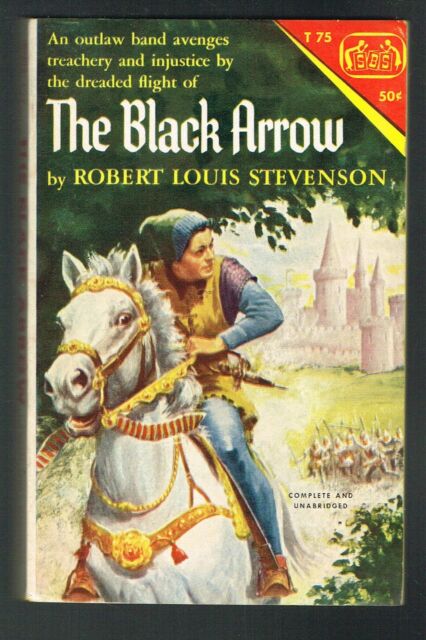Book Review: The Black Arrow by Robert Louis Stevenson
The place is England, near Tunstall Forest, and the time is the War of the Roses, circa 1460. Richard “Dick” Shelton is nearly eighteen, and looking forward to glory in battle. The other residents of Tunstall Village are less enthused. Their current liege lord, and Dick’s legal guardian, Sir Daniel Brackley, is not a man who lets loyalty get in the way of personal gain, and has fought for both York and Lancaster depending on which side was winning at the time.

One of Sir Daniel’s men, the elderly Appleyard, hints darkly at past misdeeds of himself and his lord before being murdered by a black arrow. A poem soon appears that promises that three others will die, including Sir Daniel, and makes allusion to the death of Dick’s father. This starts raising suspicions in the young man’s mind.
A short while later, while crossing a fen, Dick meets a lad calling himself John Matcham who has lost his horse, and is fleeing Sir Daniel. Despite his loyalty to his guardian, Dick agrees to get Matcham to Holywood to seek sanctuary. Along the way through the wood, they come close to being discovered by the Band of the Black Arrow, who turn out to be surprisingly sympathetic for outlaws.
A random leper turns out to be Sir Daniel in disguise, so Dick and John are coerced into coming back to Tunstall with him. There, Dick learns that Sir Daniel was in fact responsible for the death of his father, and John Matcham is actually Joanna Sedley. This young lady was meant to be wedded to Dick so that Sir Daniel could control their inheritances. Dick realizes he has a thing for Joanna, and escapes.
Rescued by the Band of the Black Arrow, Dick joins their number and swiftly rises to a leadership position. His primary objective now is to rescue Joanna from Sir Daniel, and several adventures occur before Dick meets another Richard, who will someday be king as Richard the Third. The climax is a pitched town battle between the forces of York and Lancaster!
First serialized in 1883, this novel was revised for a single volume by Robert Louis Stevenson in 1888. It’s not considered his best work (even by Stevenson himself!) but has enjoyed steady reprinting over the years.
Good: The novel has, of course, plenty of swashbuckling adventure and scenes of action to rivet the attention of the reader. More interestingly, as the story moves along, Dick learns that his actions have consequences, and there is collateral damage for each of his heroic deeds. By the end, he turns away from glory and advancement, and even revenge to live a peaceful life and make amends to at least one person he has wronged.
Less good: Stevenson used a heavy dialect for dialogue in the story to mimic the way people spoke in England in the 1460s. I don’t know how authentic it is, but it’s a chore to read.
Interesting: There’s some play with the Fifteenth Century notions of gender roles as seen from the Nineteenth Century. Dick thinks of John Matcham as a wimp, but once he finds out John is actually Joanna, Dick’s evaluation of her courage and competence rises.
Stevenson freely admits in a footnote that he’s taken some liberties with the timeline–Richard of Gloucester is a bit older than Dick in the story, but in reality he was about eight at the time. The future Richard III is depicted as a brave man, and a good war leader, but given to a foul temper and no one you’d want to be beholden to you or vice versa.
My Scholastic edition has some lovely illustrations by Cheslie D’Andrea, but the difficult dialogue means it’s more suited for senior high students and up.
Recommended to adventure fans.
